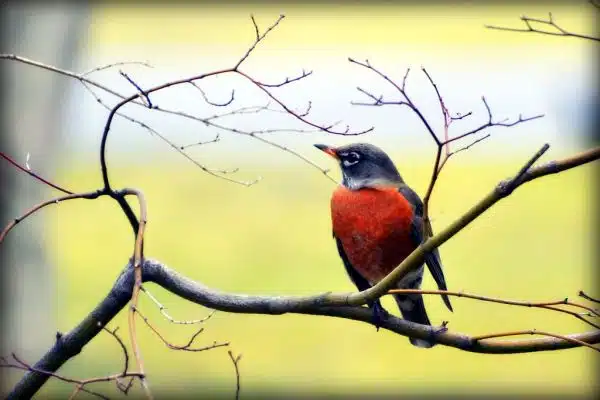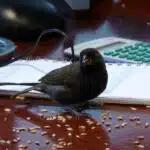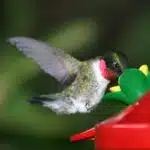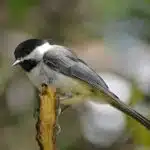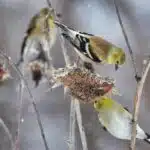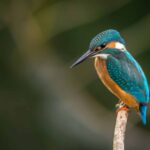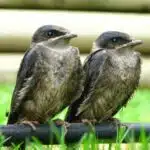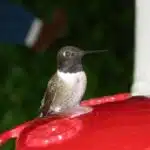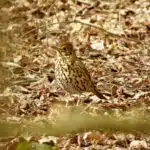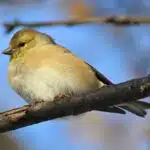The study of avian vision has been an area of interest for researchers for decades, with the aim of understanding how birds perceive their environment and navigate through it. One question that has long puzzled both ornithologists and laypeople alike is whether or not birds can see color. The answer to this question has significant implications for our understanding of avian behavior, ecology, and evolution.
While humans have trichromatic vision (the ability to perceive three primary colors), many birds possess tetrachromatic vision, meaning they can see four primary colors. This allows them to distinguish between a wide range of hues and shades that are invisible to us. However, the specific colors that birds can see and how they process this information remains an ongoing topic of research. In this article, we will delve into the fascinating world of avian vision and explore what current research tells us about whether or not birds can truly see color.
The History Of Avian Vision Research
Like a bird soaring above the clouds, the history of avian vision research stretches far back into the past. Scientists have long been fascinated by how birds navigate through their surroundings with such precision and grace. The discoveries made in this field have shed light on not only bird behavior but also on the evolution of eyesight itself.
One of the earliest examples of avian vision research dates back to 1863 when Hermann von Helmholtz proposed that birds could see colors differently from humans. This idea was based on his observation that birds had a fourth cone cell in their eyes, which would allow them to perceive ultraviolet light. This discovery sparked further interest in avian vision, and scientists began to explore the complexities of avian color perception.
Over time, researchers have made significant progress in understanding how birds see color. By studying different species and their visual systems, scientists have uncovered fascinating insights into how birds process information visually. These discoveries paved the way for further exploration into how human and avian eyes differ – a crucial area of study that has implications for fields ranging from optics to neuroscience.
How Human And Avian Eyes Differ
Comparing visual systems between birds and humans has been an area of interest for researchers for many years. Birds have a unique visual system that differs from humans in many ways. One of the most significant differences is their ability to see ultraviolet light, which humans are incapable of detecting. This ability to see UV light allows birds to navigate through complex environments, such as dense forests or murky waters.
Another difference between bird and human eyes is their visual acuity. Birds have much better visual acuity than humans, allowing them to see objects at greater distances and with more clarity. This superior acuity is due to the shape of their eye and the density of photoreceptors in their retina. The high concentration of photoreceptors allows birds to see fine details, even at great distances.
In conclusion, comparing the visual systems of birds and humans reveals significant differences in their structure and function. While both species rely on vision for survival, birds have evolved specialized adaptations that enable them to detect UV light and perceive fine details at great distances. These adaptations allow them to navigate complex environments with ease and find food sources efficiently. In the subsequent section about the science of color perception, we will delve deeper into how these adaptations influence bird behavior and ecology.
The Science Of Color Perception
With regards to the science of color perception, it is essential to understand that humans and animals differ in their ability to perceive colors. While humans possess three types of color-sensitive cones that enable us to see millions of different hues, many animals have only two or even one type of cone. This difference in the number and sensitivity of photoreceptors can affect how an animal perceives color.
One crucial aspect of color perception in avian vision is chromatic adaptation. Birds have a unique ability to adjust their visual system’s sensitivity to different wavelengths of light, allowing them to see colors more accurately in varying lighting conditions. Research has shown that birds can use this ability during migration when detecting polarized light patterns in the sky.
Additionally, studies have found that birds can distinguish between colors that appear identical to human eyes due to variations in hue or saturation. For instance, some bird species can differentiate between ultraviolet and blue light, which appears identical to humans. This highlights the importance of understanding how animals perceive color when studying their behavior and ecology.
Furthermore, understanding the intricacies of avian vision can aid conservation efforts by informing the development of bird-friendly structures and reducing bird collisions with man-made objects. In the next section, we will delve into the basics of bird vision, including their visual acuity, field of view, and color perception abilities in more detail.
The Basics Of Bird Vision
Avian eyes contain both cones and rods, which are the photoreceptors responsible for vision in birds. The ratio of cones to rods varies significantly across species, allowing for a range of color vision capabilities in birds. Studies have found that certain species of birds have a greater ability to perceive color, while others have more of a dichromatic vision. Further research is needed to understand the full range of color perception in birds and how this affects their behavior.
Bird Eye Structure
Bird Eye Structure: Exploring the Visual Adaptations of Birds
As an avian vision researcher, I have spent countless hours analyzing and studying the intricate structures of bird eyes. One of the most fascinating aspects of bird vision is their eye structure and adaptations that allow them to see with remarkable visual acuity. Bird eyes have evolved over time to enable a wide range of visual capabilities, including color perception.
Birds possess several unique adaptations in their eyes that enable them to see in ways that humans cannot. For instance, some birds have a higher density of photoreceptor cells in their retinas than humans, which allows them to detect finer details and colors. Additionally, birds have a specialized structure called the pecten oculi that helps nourish their retina and improve their visual clarity.
One key aspect of bird eye structure that contributes to color vision is the presence of cone cells. These cells are responsible for detecting different colors of light and sending signals to the brain about what colors are present in the environment. Birds have four types of cone cells (humans only have three), which means they can perceive a wider range of colors than we can. Overall, bird eye structure is incredibly complex and fascinating, and it plays a crucial role in enabling birds to navigate their environments with precision and accuracy.
Color Perception
Bird vision is a fascinating subject that has intrigued researchers and enthusiasts for decades. One of the most intriguing aspects of bird vision is color perception, which plays a crucial role in how birds interact with their environments. As an avian vision researcher, I have spent countless hours studying this subject and exploring the various ways in which birds perceive colors.
Color perception is a complex process that involves several factors, including cultural influence and genetic predisposition. In some cases, birds can be colorblind or have limited color vision, which can affect their ability to navigate their surroundings and find food. However, many species of birds have evolved specialized adaptations that enable them to detect a wide range of colors and hues.
One interesting aspect of bird color perception is how it compares to human color perception. While humans have three types of cone cells in their eyes that detect different colors (red, green, and blue), some species of birds have four types of cone cells. This means they can perceive colors that are beyond our visual range, such as ultraviolet light. Overall, understanding how birds perceive colors is essential for gaining insight into their behavior and ecological roles in the natural world.
Tetrachromatic Vision Explained
Tetrachromatic vision is the ability to see four primary colors. Unlike humans, who have three photoreceptor types responsible for color perception, birds possess a fourth type of photoreceptor called the cone cell. This enables them to see ultraviolet light, which is invisible to humans. The existence of this additional photoreceptor in birds has been studied extensively by researchers interested in avian vision.
One advantage of tetrachromatic vision is that it improves a bird’s ability to detect and identify prey. For example, some insects reflect UV light differently than visible light, making them easier for birds to spot with tetrachromatic vision. In addition, birds may use their ability to see UV light for navigation or communication purposes as well. This unique adaptation gives birds an edge over other animals that lack tetrachromatic vision.
Despite the advantages of tetrachromatic vision, there are also limitations. For instance, seeing too many colors could be overwhelming and might make it difficult for birds to differentiate between similar hues. Additionally, color perception can vary depending on lighting conditions or distance from an object. Therefore, while tetrachromatic vision has its benefits, it is not without its drawbacks.
Moving forward into the next section, it will be interesting to explore the range of colors that birds can see with their unique visual abilities. While we know that they can perceive ultraviolet light and have a wider range of color sensitivity than humans do, understanding more about the specifics of their visual system could provide valuable insights into how they interact with their environment and other species around them.
The Range Of Colors Birds Can See
The range of spectral sensitivity varies among bird species. Some birds have color vision that extends into the ultraviolet (UV) range, while others have a more limited color discrimination ability. UV sensitivity is particularly important for birds that rely on visual cues to locate food, such as nectar and fruit. For example, hummingbirds can see beyond the violet end of the spectrum, which helps them locate flowers that reflect UV light.
Color discrimination abilities also vary among bird species. While humans have three types of color-detecting cells in their eyes (cones), some birds have up to five types. This additional cone type allows them to discriminate between colors that appear identical to humans. For instance, researchers believe that certain bird species are able to differentiate between different shades of yellow and green.
Overall, it is clear that birds have a remarkable ability to perceive colors across a wide range of the electromagnetic spectrum. However, it is important to note that not all bird species have equal color vision capabilities.
Markdown list:
- Bird species’ spectral sensitivity range varies
- Ultraviolet sensitivity is crucial for locating food
- Some birds possess up to five types of cones for enhanced color discrimination
As an avian vision researcher, I find it fascinating how birds are able to perceive colors in ways that are beyond human comprehension. Understanding their range of spectral sensitivity and color discrimination abilities can provide insights into how they utilize visual cues in their environment.
Transition: Now that we know about the range of colors birds can see, let’s explore how they use this ability to navigate their environment.
How Birds Use Color To Navigate Their Environment
Birds have evolved colorful adaptations that enable them to see a wide range of colors. As avian vision researchers, we study the visual cues in bird habitats that help these creatures navigate their environment. One such cue is color, which plays an essential role in many aspects of bird behavior.
Birds use color in various ways to navigate their surroundings. The ability to see vibrant hues helps them identify food sources, mates, and potential predators. For instance, some birds have developed ultraviolet-sensitive cones that allow them to distinguish between different flower species based on the color patterns invisible to humans. Additionally, colorful plumage serves as a visual signal for species recognition and mate choice.
Colorful adaptations are also critical for birds’ survival in their environment. For example, some birds have camouflage plumage that blends into their habitat’s vegetation or rocks, making it difficult for predators to spot them. On the other hand, bright colors like red or yellow can be a warning sign indicating toxicity or danger.
In summary, the role of color in bird behavior goes beyond aesthetics. It serves as a vital tool for navigating their environment and surviving in it. In the next section, we will delve deeper into how color impacts bird mating behaviors and explore its evolutionary significance.
The Role Of Color In Bird Mating Behaviors
Color plays an important role in bird mating behaviors, particularly in the selection of mates. Research has shown that birds have a color preference and that this preference is often linked to their genetic makeup. In many species, males are brightly colored while females are duller in coloration.
For example, male birds of paradise exhibit highly elaborate and colorful plumage that they use to attract females during courtship displays. Similarly, male peafowl display their vibrant iridescent tail feathers during courtship rituals to attract female partners. In both cases, the bright colors serve as signals of good health and genetic fitness.
The genetic basis for color preference is still not fully understood, but it is thought to be related to the visual system of birds. Recent studies have shown that birds have much more complex color vision than was previously believed. This research suggests that differences in color perception among bird species may play a significant role in mate selection and other social behaviors.
Differences In Color Perception Among Bird Species
The Role of Color in Bird Mating Behaviors sheds light on the importance of color perception in birds. But what about their actual ability to see color? The answer is yes, but not all birds perceive colors in the same way. Differences in Color Perception Among Bird Species can be attributed to their eye structure and tetrachromatic adaptation.
Tetrachromatic adaptation is a unique trait found in some bird species that allows them to see four primary colors instead of three like humans. This adaptation results from having four types of cone cells in the retina rather than three, which enables these birds to perceive a wider range of colors, including ultraviolet light. Birds that possess this ability are better equipped to navigate their environment, locate food sources, and identify potential mates.
Interestingly, not all bird species have tetrachromatic vision. Birds of prey such as eagles and hawks have only three types of cone cells, making them trichromatic like humans. However, they still possess exceptional color perception skills due to their visual acuity and superior depth perception. Their eyes are designed for hunting and tracking prey with precision, allowing them to detect even the slightest movement or color variation from great distances.
Understanding color perception in birds is crucial for researchers studying avian vision. By studying differences in color perception among bird species, we can gain insight into how these animals interact with their environment and make important life decisions such as finding a mate or locating food sources. Furthermore, understanding the evolutionary advantages of tetrachromatic vision can help us better understand not just bird biology but also our own visual system and its limitations.
The Evolutionary Advantages Of Tetrachromatic Vision
Evolutionary implications of tetrachromatic vision in birds are significant. The ability to perceive a greater range of colors may have helped them find food, mates, and avoid predators. It is believed that tetrachromatic vision evolved in birds from their dinosaur ancestors around 300 million years ago. This evolution occurred alongside the development of colored feathers and fruits, which suggests that tetrachromacy was instrumental in recognizing these new sources of food.
Advantages of tetrachromatic vision go beyond just identifying prey or food sources. Birds with this ability can also navigate better in complex environments such as forests or dense vegetation where color variations are abundant. Additionally, it allows them to detect subtle changes in their environment such as temperature, humidity, and even ultraviolet light reflected by flowers, which can help them identify suitable breeding sites.
The evolutionary advantages of tetrachromacy in birds have helped them adapt to their changing environments over millions of years. This adaptation has not only improved their survival but also increased their chances for successful reproduction. Understanding the complexities of avian vision can provide insights into how they interact with their environment and help us appreciate the diversity of life on Earth.
With this understanding comes an appreciation for what birds see that we cannot. In the subsequent section, we will explore how avian vision differs from human vision and examine some of the unique features that allow birds to see the world differently than us.
What Birds See That We Can’t
As avian vision researchers, our fascination with the eyesight of birds goes beyond their ability to see colors. Birds possess a unique visual system that allows them to perceive a wide range of light beyond what humans are capable of. In addition to the visible spectrum, birds have the ability to detect ultraviolet (UV) light and even see in low-light conditions.
One of the most intriguing aspects of bird vision is their infrared detection capabilities. While humans rely on technology to detect heat signatures, some bird species use their specialized retinas to sense thermal radiation emitted by prey or potential threats. This adaptation has allowed certain bird species, such as owls and nightjars, to become highly successful nocturnal hunters.
Another remarkable feature of avian vision is their ability to see UV light. Unlike humans who perceive a rainbow of colors with three types of color receptors in our eyes, birds have four color receptors that include sensitivity to UV wavelengths. This enables them to distinguish between subtle differences in plumage patterns and identify ripe fruits that appear invisible to us.
In summary, avian vision research continues to unravel the mysteries surrounding these fascinating creatures’ visual systems. From their infrared detection abilities to their UV vision capabilities, birds possess unique adaptations that allow them to thrive in various environments. As we strive towards understanding how they perceive the world around them, it opens up exciting possibilities for future advancements in fields such as robotics and imaging technology.
The Future Of Avian Vision Research
Future advancements in avian vision research will be driven by technological innovations that allow for a greater understanding of bird vision. One of the key areas of research will focus on identifying the specific wavelengths that birds can see. This will require advanced imaging techniques and sophisticated software that can analyze the data collected. Once identified, this information could be used to develop new technologies that improve bird conservation efforts, as well as inform our understanding of how birds interact with their environment.
Another area of future research will explore how birds use color vision in complex tasks such as foraging and mate selection. Researchers will need to develop new experimental methods to test these behaviors, such as virtual reality environments or robotic prey models. Understanding the role color vision plays in these behaviors will provide valuable insights into the evolution and ecology of birds.
Overall, future advancements in avian vision research promise to reveal fascinating new insights into how birds perceive their world. These discoveries may have significant implications for human society, ranging from improving bird conservation efforts to inspiring advances in technology and medicine.
This growing body of knowledge about avian vision is not only important for understanding the natural world but also has practical applications for humans. By studying bird visual systems, researchers can gain insights into human visual processing disorders and develop new treatments. Additionally, improvements in optics and image processing developed through avian vision research may lead to better medical imaging technologies or even enhance our ability to observe distant galaxies through telescopes. The potential benefits of avian vision research are vast and exciting, making it a field ripe for continued exploration and discovery.
How Avian Vision Research Benefits Humans
Recent studies have revealed that birds possess remarkable visual abilities, including the ability to see a wider range of colors than humans. This discovery has caused a significant shift in the understanding of avian vision and its potential applications. Avian vision research has far-reaching implications for various fields, including medical diagnosis and technology development.
The medical field can benefit from avian vision research in several ways. For instance, birds’ unique visual abilities can aid in developing new diagnostic tools for detecting certain medical conditions. Additionally, studying birds’ perception of color and light can lead to better understanding of human vision impairments such as color blindness.
Furthermore, avian vision research also has numerous applications in technology development. By learning how birds’ eyes function, researchers can develop technologies that mimic their abilities. For example, engineers are using insights from bird vision to design drones with superior navigational capabilities. In addition, studying how birds see could inspire advancements in camera and display technologies.
Understanding avian vision is crucial not only for scientific advancement but also for protecting the well-being of these creatures. As we continue to learn more about birds’ visual abilities, it is important to ensure that our actions do not harm them or their habitats. The importance of protecting birds’ vision cannot be overstated – doing so will help us advance our knowledge while respecting the natural world around us.
The Importance Of Protecting Birds’ Vision
Studies have shown that healthy habitats, with abundant vegetation and natural light, are essential for maintaining healthy avian vision. Light pollution, on the other hand, has been found to have a drastically negative effect on birds’ vision and should be minimized as much as possible. The ability of birds to see color is often dependent on the amount and type of light available in their habitats. Thus, protecting birds’ vision requires a balance of maintaining healthy habitats and reducing light pollution.
Maintaining Healthy Habitats
Research on avian vision has shown that birds have the ability to see a wide range of colors. They have four types of color receptors in their eyes, which allows them to perceive colors differently from humans. This ability is essential for birds to navigate and survive in their habitats, where they need to recognize different food sources, predators, and mates.
Maintaining healthy habitats is crucial for birds to thrive and maintain their visual capabilities. Habitat preservation ensures that birds have access to a variety of food sources and nesting sites, which are essential for their survival. Conservation efforts aimed at protecting bird habitats also help maintain the health of ecosystems by preserving biodiversity. By maintaining healthy habitats, we can ensure that birds continue to play a vital role in pollination and seed dispersal.
Conservation efforts aimed at protecting bird habitats not only benefit the birds but also have positive impacts on human communities. Birds are important indicators of ecosystem health and changes in bird populations can signal environmental problems that may affect human health as well. By taking steps towards habitat preservation and conservation, we can protect not only the birds but also our own well-being. It is important that we continue to educate ourselves on how we can contribute towards maintaining healthy bird habitats and make conscious efforts towards preserving biodiversity for future generations.
Reducing Light Pollution
Birds rely on their vision to navigate and survive in their habitats. As previously discussed, avian vision is unique and enables birds to perceive a wide range of colors. However, human activities such as light pollution can have detrimental effects on bird behavior and disrupt their visual capabilities. Light pollution refers to the excessive use of artificial light, particularly at night, which can cause problems for nocturnal bird species.
As researchers of avian vision, it is important that we address the impact of light pollution on bird behavior. Studies have shown that exposure to artificial light at night can alter the timing of migration and breeding cycles in birds. Additionally, nocturnal species are particularly affected by light pollution as it can disorient them during foraging and mating activities. Therefore, it is crucial that we develop effective strategies to reduce light pollution and preserve the natural environments where birds thrive.
Reducing light pollution can be achieved through various strategies such as using motion sensors or timers for outdoor lighting, installing shades or reflective surfaces on windows to reduce indoor lighting glare, and promoting dark sky policies in urban areas. By implementing these initiatives, we not only protect birds’ visual capabilities but also contribute towards maintaining healthy ecosystems. As researchers and advocates for avian vision conservation, we must continue to educate ourselves on how we can reduce light pollution and make conscious efforts towards preserving biodiversity for future generations.
Conclusion: The Fascinating World Of Bird Vision
Researchers in the field of avian vision have long been fascinated by the remarkable abilities of birds to perceive colors. The visual systems of birds differ significantly from those of humans, with many species possessing a greater range of color vision and sensitivity to ultraviolet light. The study of bird vision has important implications for understanding the evolution of sensory systems and the impact of environmental factors on visual perception.
One major difference between bird vision and human perception is the presence of four types of cone cells in many bird species, compared to three in humans. This enables birds to detect a wider range of colors, including ultraviolet wavelengths that are invisible to humans. Birds also have a higher density of cone cells than humans, allowing for greater acuity and discrimination between subtle differences in color.
The impact of environmental factors on avian color vision is an area of ongoing research. For example, some studies suggest that exposure to pollutants or changes in habitat can affect the spectral sensitivity and color discrimination abilities of certain bird species. Understanding how birds’ visual systems respond to these environmental pressures can provide valuable insights into conservation efforts and protecting these fascinating creatures for generations to come.
Conclusion
The study of avian vision has a rich history that spans centuries. Research into the intricacies of bird vision has revealed striking differences between human and avian eyes, including the presence of tetrachromatic vision in many bird species. This unique ability allows birds to perceive colors outside the range of human vision, making their world a vibrant and fascinating place.
As researchers continue to explore the complexities of avian vision, they are uncovering new insights into color perception and its role in bird behavior. These findings not only expand our understanding of the natural world, but also offer practical applications for fields such as conservation biology and agriculture.
Despite these exciting discoveries, it is crucial that we recognize the importance of protecting birds’ vision by minimizing exposure to harmful pollutants and other environmental hazards. By doing so, we can ensure that these remarkable creatures continue to thrive in their colorful and dynamic habitats for generations to come. The fascinating world of bird vision awaits further exploration, offering endless possibilities for discovery and innovation.
Image Credits
- “Sure sign of Spring – Robin – Bird” by blmiers2 (featured)

